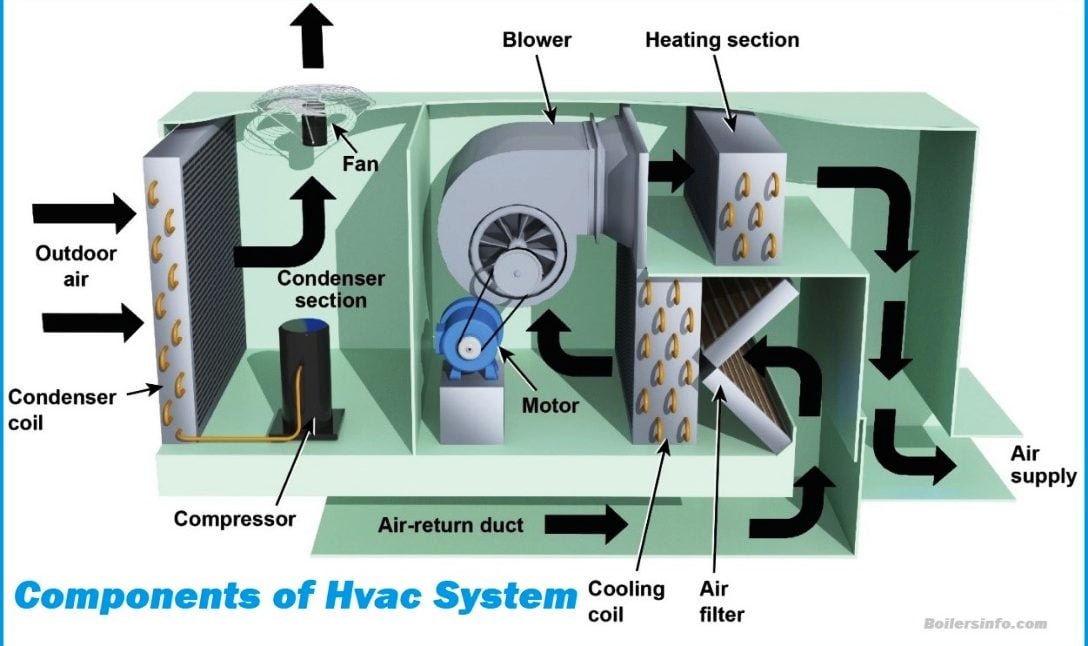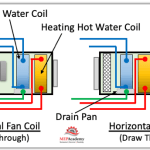Parts of HVAC System: If you’ve ever wondered how your home or office is kept comfortable all year round, it’s essential to understand the different components that make up an HVAC system. HVAC stands for heating, ventilation, and air conditioning, and it is comprised of several parts that work together to regulate the temperature, humidity, and air quality of your indoor space. In this blog post, we will explain the main components of an HVAC system and how they work.
Here are the most important parts of HVAC System
1-Thermostat
The thermostat is the component of your HVAC system you interact with the most. It controls the heating and cooling units based on your preferred settings. The thermostat lets you adjust your HVAC system’s temperature, fan speed, mode, and schedule. Different types of thermostats, including manual, programmable, and intelligent, offer additional features and benefits.
2-Evaporator
The evaporator is an essential HVAC system component that cools the air. It is a coil containing a refrigerant, a liquid that can absorb heat and transform it into a gas. As the warm air from your indoor space passes over the evaporator coil, the refrigerant absorbs the heat and evaporates, resulting in cool and dehumidified air. Typically, the evaporator is situated inside the air handler or the indoor unit of the HVAC system.
3-Compressor
The compressor is an essential component of the HVAC system. It is responsible for compressing the refrigerant, which is a gas that comes from the evaporator. This pump is located outside the building, in the condensing unit, or in the outdoor unit of the HVAC system. Its function is to increase the pressure and temperature of the refrigerant gas, which makes it easier to transfer heat between indoor and outdoor environments.
4-Duct
The duct is a crucial part of HVAC System that significantly distributes the conditioned air. It is a system of pipes or tubes that carries the conditioned air from the air handler to the vents and the return air from the vents back to the air handler. The ducts are typically made of metal, fiberglass, or plastic and are insulated and sealed to prevent air leaks and heat loss. Additionally, the vents may have dampers, which are valves that regulate the airflow and direction of the air for optimal ventilation.
5-Air Handler
The air handler, a vital HVAC component, moves air using a unit housing a blower fan, motor, air filter, and evaporator coil. The fan circulates air through ducts and vents, with the engine powering the components. An air filter traps particles and the evaporator coil cools the air by absorbing heat. They are typically situated indoors in the attic, basement, or closet.
You Can Also Read More About 11 Common HVAC Mistakes That Can Cost You Money And Comfort
6-Heat Exchanger
The key HVAC component heat exchanger heats the air within a metal chamber featuring a burner, flame sensor, and flue. The burner ignites fuel like natural gas, propane, or oil, creating a flame. A flame sensor ensures safety, shutting off the gas valve if the flame goes out. The flue expels combustion gases and steam outdoors. Positioned inside the furnace or indoor HVAC unit, the heat exchanger transfers flame-generated heat to passing air, warming it efficiently.
7-Condenser
The condenser is a part of the HVAC system responsible for condensing the refrigerant. It is a coil containing a refrigerant, a gas that can release heat and change into a liquid. When the hot and high-pressure refrigerant gas from the compressor passes over the condenser coil, the refrigerant removes the heat and condenses, turning it back into a liquid. The condenser is usually located outside the building, in the condensing unit, or in the outdoor unit of the HVAC system.
8-Furnace
The furnace is a part of the HVAC system responsible for providing heat. It is a unit that contains a heat exchanger, a blower fan, a motor, an air filter, and a gas valve. The heat exchanger warms air by transferring heat from the flame. A blower fan circulates heated air through ducts and vents, returning cold air. The motor powers components and the air filter traps particles. A gas valve controls fuel flow to the heat exchanger. It is typically situated indoors in basements, attics, or closets.
9-Heat Pump
The heat pump is a part of the HVAC system responsible for heating and cooling. It is a unit that contains a compressor, a condenser, an evaporator, and a reversing valve. The heat pump reverses the refrigerant cycle, depending on the mode. The heat pump works like an air conditioner in the cooling mode, with the evaporator inside the building and the condenser outside the structure. In the heating mode, the heat pump works like a heater, with the evaporator outside the construction and the condenser inside the building.
10-Expansion Valve
The expansion valve is a part of the HVAC system regulating the refrigerant flow. It is a valve that controls the amount and the pressure of the refrigerant that enters the evaporator. The expansion valve reduces the pressure and the temperature of the refrigerant liquid, making it easier to evaporate and absorb heat. The expansion valve is usually located between the condenser and the evaporator in the indoor or outdoor unit of the HVAC system.
You Can Also Read More About When To Use Emergency Heat On Heat Pump
11-Air Filter~Parts of HVAC System
The air filter is a part of the HVAC system responsible for filtering the air. It is a device that traps dust, dirt, pollen, pet dander, and other particles from the air before it enters the heating or cooling units. The air filter improves the air quality and the efficiency of the HVAC system, as it prevents the particles from clogging or damaging the components. The air filter is usually located in the air handler, the furnace, or the return air duct, and it should be replaced or cleaned regularly.
12-Centrifugal Fan
The centrifugal fan is a part of the HVAC system that creates the airflow. It is a fan with curved or angled blades that spin around a central hub. The centrifugal fan draws the air from the center and pushes it out to the sides, creating a high-pressure and high-velocity airflow. The centrifugal fan is usually located in the air handler, the furnace, or the condensing unit, and a motor powers it.
13-Refrigerant
Refrigerant, a vital HVAC component, transfers heat as a versatile liquid or gas sensitive to pressure and temperature changes. It absorbs indoor air heat in the evaporator, releasing it to outdoor air in the condenser. This cycle includes the compressor, condenser, expansion valve, and evaporator. Typically, synthetic chemicals like R-22, R-410A, or R-134a refrigerants have distinct properties and environmental impacts.
14-Condensing Unit ~ Parts of HVAC System
The condensing unit is a part of the HVAC system responsible for housing the condenser, the compressor, and the fan. It is a unit located outside the building and connected to the indoor unit by the refrigerant lines. The condensing unit cools, condenses the refrigerant gas from the compressor, and sends it back to the indoor unit. The condensing unit also dissipates the heat from the refrigerant to the outdoor air and protects the components from the weather and debris.
You Can Also Read More About the Major Benefits Of HVAC Maintenance That You Should Know in 2023
15-Damper
The damper is a part of the HVAC system responsible for controlling the airflow. It is a valve or a plate that can open or close to adjust the amount and the direction of the air that passes through the ducts or the vents. The damper can be manual or automatic, and a thermostat, a timer, or a sensor can control it. The damper can help balance the airflow, regulate the temperature, and improve the efficiency of the HVAC system.
16-Combustion Chamber
The combustion chamber is a part of HVAC system responsible for fuel burning. It is a metal chamber that contains a burner, a flame sensor, and a flue. The burner ignites the fuel, such as natural gas, propane, or oil, and creates a flame. The flame sensor detects the presence of the flame and shuts off the gas valve if the flame goes out. The flue is a pipe that carries the combustion gases and steam from the combustion chamber to the outside.
17-Fan Coil Unit
The fan coil unit is a part of the HVAC system responsible for heating or cooling to a specific area. It is a unit that contains a fan, a coil, and a filter. The fan moves the air over the coil, which can be heated or cooled by hot water or a chilled water system.
18-Humidifier
The humidifier, a vital HVAC component, adds moisture to indoor air using water or steam. This enhances comfort and occupants’ health while preventing dryness, static electricity, and damage to woodwork and furniture. Humidifiers can be standalone units or part of the air handler or furnace. These devices are controlled by a humidistat and efficiently measure and regulate indoor humidity levels.
19-Chiller~Parts of HVAC System
The chiller is a part of HVAC system responsible for cooling the water or the refrigerant. It is a unit that uses a compressor, a condenser, an evaporator, and an expansion valve to remove the heat from the water or the refrigerant and lower its temperature. The chiller can be air-cooled or water-cooled, depending on the condenser type. The chiller can provide chilled water or refrigerant to the fan coil units, the air handlers, or the heat pumps, which can cool the air in the indoor space.
20-Boiler
The boiler is a part of the HVAC system responsible for heating the water or the steam. It is a unit that uses a burner, a heat exchanger, a pump, and a flue to heat the water or the steam and raise its temperature and pressure. The boiler can use different fuel types, such as natural gas, propane, oil, or electricity, to create the heat. The boiler can provide hot water or steam to the fan coil units, the air handlers, or the heat pumps, which can heat the air in the indoor space.
21-Air Conditioning
The air conditioning is a part of HVAC system responsible for cooling and dehumidifying. It is a process that uses a refrigerant cycle to transfer the heat from the indoor air to the outdoor air, lowering the indoor air’s temperature and humidity level. Depending on the indoor space’s size and layout, the air conditioning can be provided by different units, such as window, split, packaged, or central units.
Parts of HVAC System~Conclusion
The HVAC system is a vital part of regulating your indoor space. By understanding its parts and functions, you can appreciate its benefits, maintain it better, and know when to call for professional help. If you have any questions or comments, please leave them below.




